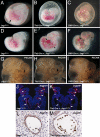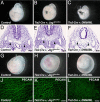Endothelial expression of the Notch ligand Jagged1 is required for vascular smooth muscle development
- PMID: 18245384
- PMCID: PMC2538864
- DOI: 10.1073/pnas.0709663105
Endothelial expression of the Notch ligand Jagged1 is required for vascular smooth muscle development
Abstract
The Notch ligand Jagged1 (Jag1) is essential for vascular remodeling and has been linked to congenital heart disease in humans, but its precise role in various cell types of the cardiovascular system has not been extensively investigated. We show that endothelial-specific deletion of Jag1 results in embryonic lethality and cardiovascular defects, recapitulating the Jag1 null phenotype. These embryos show striking deficits in vascular smooth muscle, whereas endothelial Notch activation and arterial-venous differentiation appear normal. Endothelial Jag1 mutant embryos are phenotypically distinct from embryos in which Notch signaling is inhibited in endothelium. Together, these results imply that the primary role of endothelial Jag1 is to potentiate the development of neighboring vascular smooth muscle.
Conflict of interest statement
The authors declare no conflict of interest.
Figures




References
Publication types
MeSH terms
Substances
Grants and funding
LinkOut - more resources
Full Text Sources
Other Literature Sources
Molecular Biology Databases

